BRD Prevalence Study Results
Prevalence of Bovine Respiratory Disease in Pre-Weaned Dairy Calves in Northern California
Objective:
The objective of this cross-sectional study was to estimate the prevalence of respiratory disease (BRD) in pre-weaned dairy calves and identify herd and calf level management practices that may be risk factors for BRD.
Study Method:
During the summer and early fall of 2014, we visited 31 dairies in three regions of Northern California (Humboldt, Del Norte- Region 1; Sonoma, Marin, Mendocino- Region 2; Glenn, Tehama, Yuba- Region 3). A survey focusing on calf management practices and relevant demographic information was completed at each dairy. Sections of the survey included Dam/Calving Management, Colostrum Management, Pre-Weaned Calf Management, Vaccinations & Testing, Other Risk Assessment Questions and Maternity Pen Observations.
Calves currently raised on each dairy were randomly sampled and evaluated using the California BRD scoring system. Calves were considered positive for BRD if their score was equal to or greater than five. Ammonia levels (ppm) were measured utilizing a handheld ammonia meter (Dräeger Safety, Lübeck, Germany).
Results:
Table 1. Demographics and Prevalence by Region
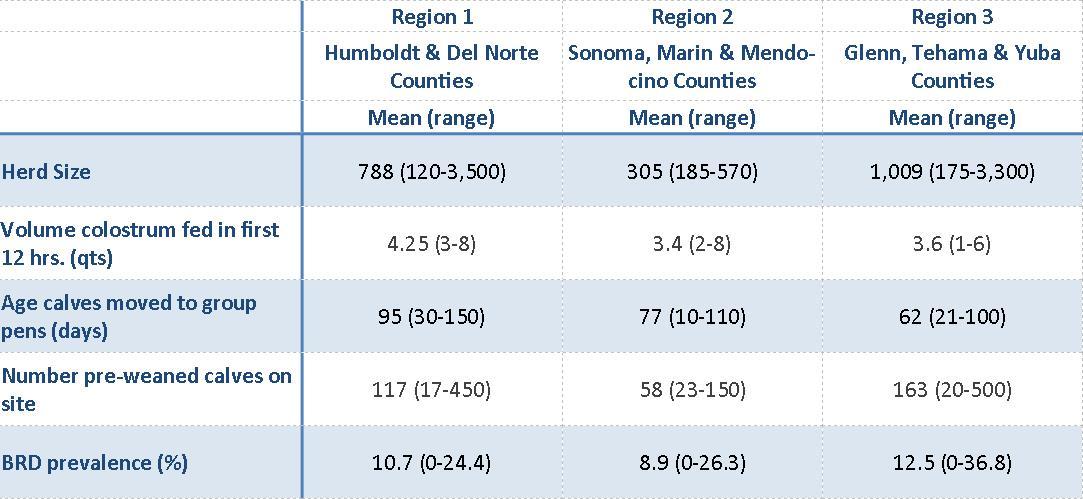
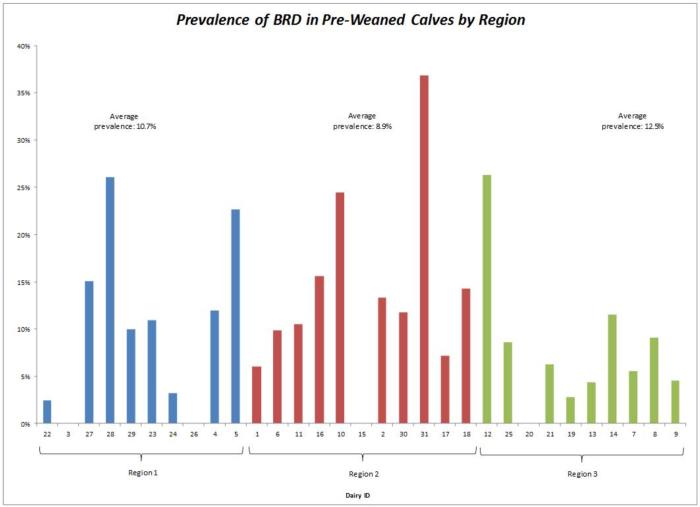
A total of 1,438 calves were evaluated, and the average BRD prevalence was 10.2%. The difference in prevalence across the regions was not statistically significant. The observed prevalence of BRD in Holstein calves was 7.2%, compared to 15.9% and 12.1% for Jerseys and all other breeds, respectively. Jersey calves were 2.2 times more likely to be positive for BRD in this study.
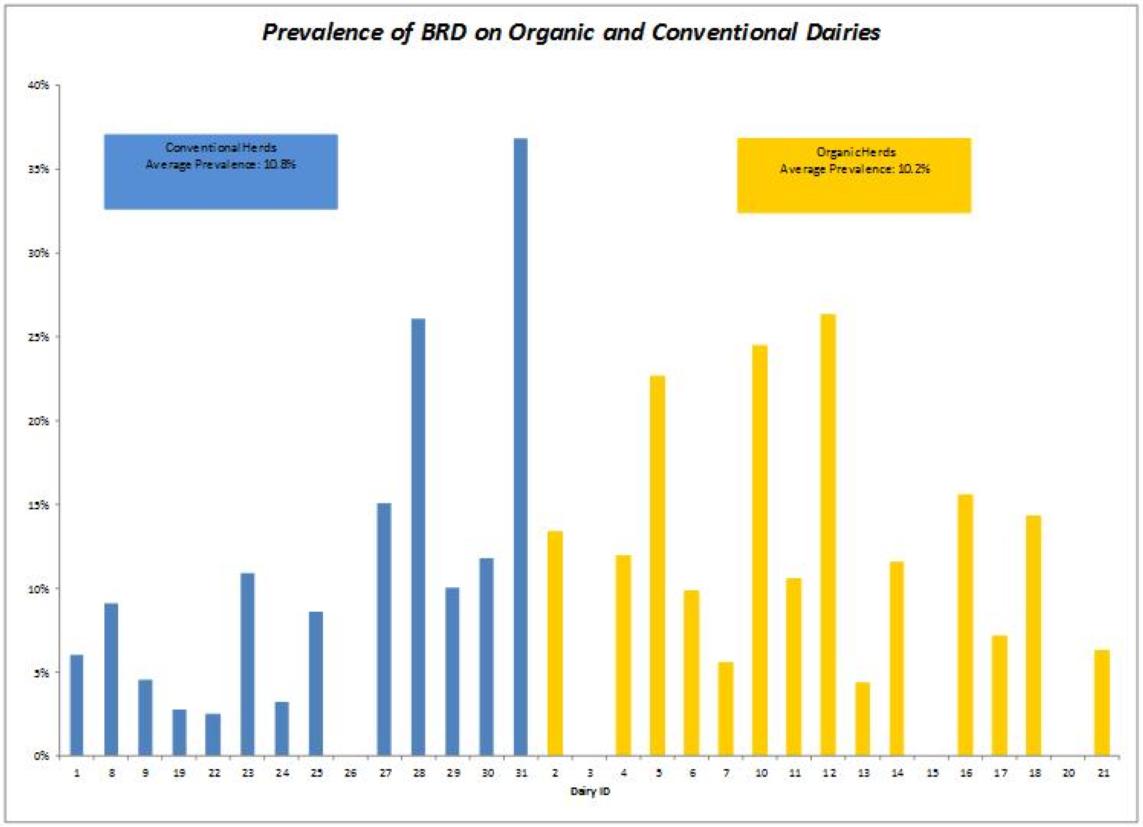
More than half (54.8%) of the dairies visited were certified organic and were located exclusively in Regions 1 and 2 on the North Coast. Overall BRD prevalence was 10.5% on organic dairies and 10.8% on conventional dairies, which was not statistically different.
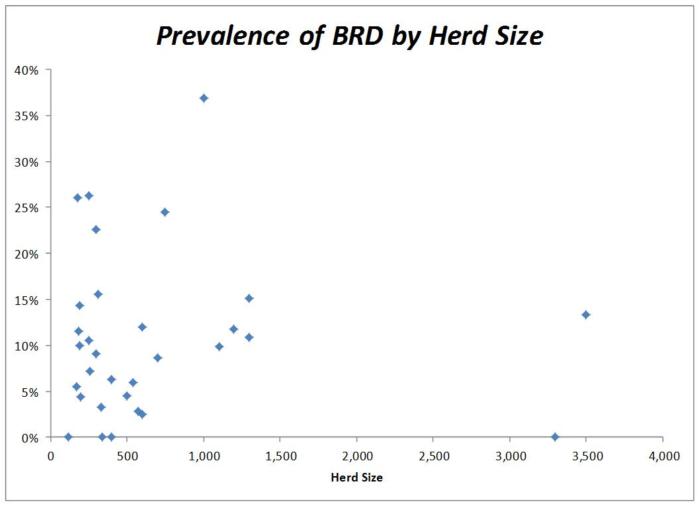
Herd size was not significantly associated with BRD prevalence. Additional herd level effects, including average volume of colostrum fed within 12 hours of birth, testing colostrum for IgG concentration or average age that calves were moved to group pens were not significantly associated with BRD prevalence. (Note: even though it wasn’t associated with BRD prevalence in this study, we still recommend prompt feeding of good quality colostrum.)
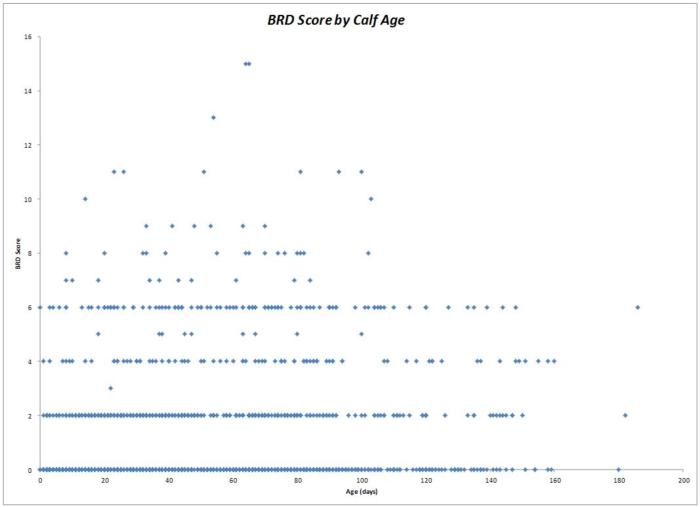
When looking at the data for calves individually, the age of the calf did not affect the likelihood of a positive BRD score. Airborne ammonia concentrations within 1 foot of the hutch or housing floor were low overall and not associated with BRD prevalence. There was also no difference in prevalence between bulls and heifers.
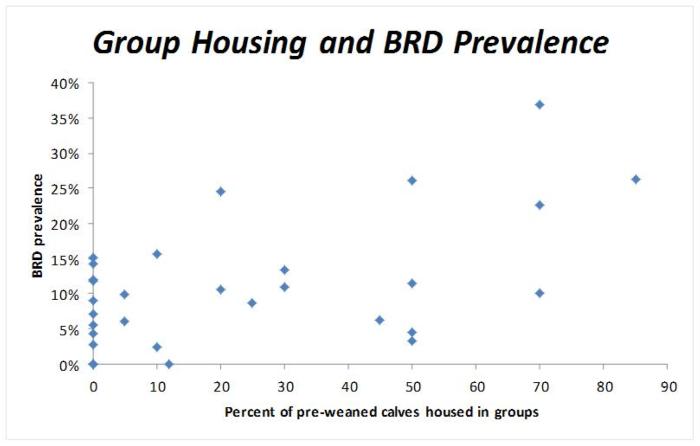
About 70% of the dairies surveyed used some degree of group housing for pre-weaned calves, with pens containing between 2 to 40 calves. Group housing was associated with increased odds of BRD compared to calves that were housed individually. Each additional calf in a pen was associated with a 7% increase in BRD.
Summary:
BRD prevalence estimates between zero to nearly 40% were observed in this cross-sectional study. We observed a correlation between calves that were housed in groups and increased risk of BRD. The probability of Jersey calves being affected by BRD was more than twice that of Holsteins. Though differences between regions of Northern California were apparent, they were not statistically significant and calves on organic dairies were no more or less likely to be affected with BRD at the time of observation. We will collect additional data in other regions of California and analyse further management practices that affect prevalence of respiratory disease in pre-weaned dairy calves. The data presented in this study underscore the complexity of this disease and the need to further examine risk factors and management practices.
Acknowledgements: Thank you to Paulette Swallow, Emma Briggs, Jessie Peterson and all participating dairy producers for their assistance.
Authors:
Betsy M. Karle- University of California Cooperative Extension, Orland, CA (bmkarle@ucanr.edu)
Sasha A. Dubrovsky- Department of Animal Science, University of California, Davis
William J. Love- UC Davis Veterinary Medicine Teaching and Research Center, Tulare, CA
Deniece R. Williams- UC Davis Veterinary Medicine Teaching and Research Center, Tulare, CA
Jeffery W. Stackhouse- University of California Cooperative Extension, Eureka, CA
Randall J. Anderson- California Department of Food and Agriculture, Animal Health Branch, Sacramento, CA
Alison L. Van Eenennaam- Department of Animal Science, University of California, Davis
Terry W. Lehenbauer- UC Davis Veterinary Medicine Teaching and Research Center, Tulare, CA and Department of Population Health and Reproduction, School of Veterinary Medicine, University of California, Davis
Sharif S. Aly- UC Davis Veterinary Medicine Teaching and Research Center, Tulare, CA and Department of Population Health and Reproduction, School of Veterinary Medicine, University of California, Davis
For a complete copy of this report in PDF format, click here Research Report- N Cal survey .
